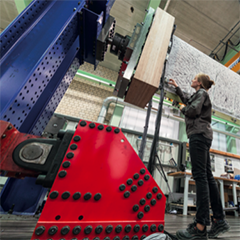Abstract: The continuing increase in rotor diameters is pushing the structural load-carrying capabilities of turbine blades to the limit. In order to ensure reliability and structural integrity, representative testing and validation methods are now more important than ever before.
Development in wind turbine blades
Wind turbine manufacturers are continuing to increase rotor diameters with the aim of boosting annual energy production (AEP). Due to the high installation costs per turbine, this is especially true for offshore blades, but onshore turbines are also increasing in size, as multi-megawatt turbines are being developed for lower wind speeds.
Direct scaling of blade dimensions would result in a cubic relationship between blade mass and blade length. However, this is certainly too conservative for some areas of the blade, for example the skin panels, which need to scale with the blade surface area. Thus, a theoretical scaling exponent below three is expected. In the past, this ‘square-cube law’ has repeatedly been beaten due to both design and material innovations, and scaling factors between 2.2 and 2.4 have been reported. This illustrates how structural load carrying capabilities are pushed to the limits.
Put simply, mechanical loads on wind turbine blades can be categorized into flapwise loads, which are caused directly by the wind, and edgewise loads, which originate from the generated torque and the gravitational loads.
Spar caps consisting of unidirectional glass or carbon fiber reinforced polymers (GFRP/CFRP) carry the main loads in the direction of the flap. The edge bending moment is predominantly taken up by the leading and trailing edge, which are often reinforced with additional unidirectional layers.
As gravitational loads become more influential compared to wind loads for longer blades, the structural load-carrying capability of the leading and trailing edge is of increasing importance. Take for example a typical turbine with a 20-year operational life, a 120m rotor, and a tip speed of 80 m/s, the resulting loads across the blade’s leading and trailing edge will change as a result of gravity changes approx. 100 million times. This high number of cycles combined with high material loading and the variability of the loads make blades one of the highest fatigue-loaded technical structures.
Assuming unchanging or similar materials for future blades, structural reserves can only be better utilized by reducing safety margins. As the structural reliability is not to be reduced, this requires a much better understanding of material and structural behavior. As such, great efforts are invested in capturing and predicting the damage behavior of blades and the influence of manufacturing effects. Evaluation of manufacturing defects becomes of the utmost importance for long blades, as the costs attached to discarding a blade increase exponentially with the blade length.
Using a similar argument, the importance of detecting design flaws as early as possible in the design process increases with the high development costs of very long blades. Consequently, extensive and representative validation and testing campaigns are desired throughout the design process.



























